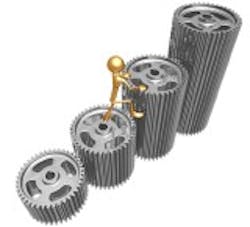Analyst: Softening outlook for industrial lasers
Projections for industrial laser growth in 2012 and even 2013 need to be revised downward, says Longbow Research analyst Mark Douglass, citing concerns about European and Chinese spending, but microelectronics remains a bright spot.
Among the key themes Douglass shares in a new report, gleaned from conversations and observations during the recent LASYS event in Stuttgart, Germany:
-- The outlook is becoming more muted. Growth projections for industrial laser systems in 2012, and even 2013, need to be revised downward, he says -- not to a contraction, just not as robust as previously hoped, slowing over general industrial laser applications including cutting, welding, and marking. The persistent European debt crisis and uncertainty about Chinese growth is making end users more cautious in spending for capital goods in general, which filters down to laser systems. Optech Consulting, for example, now sees flat growth in 2012 for industrial laser systems, following 28% in 2011 and 49% in 2010. (A few weeks ago ILS' own David Belforte updated his market outlook reaffirming ~6% annual growth in 2012.)
-- One bright spot: Microelectronics. Despite the slowdown sentiments, there appears to be continued strong interest in microelectronics as a key growth end-market. Douglass thinks this could be "one of the bright spots of 2H12" after "a spending pause the past few quarters," driven by trends including handheld devices and new Windows 8 notebooks coming out later this year.
Several laser applications at play in microelectronics (citing feedback from Coherent): frontend lithography (photomask writing/inspection, wafer inspection, laser anneal), backend lithography (wafer dicing, scribing, and marking), semiconductor packaging (via hole drilling, glass cutting), printed circuit boards (hole drilling, laser direct imaging), flat-panel displays (annealing, glass cutting, touchscreen patterning), and solar (scribing and drilling). LCD and OLED manufacturing in particular, Douglass points out, "is a significant opportunity that ramps more significantly in FY13." Another growth area for high-power CO2 lasers in semiconductor manufacturing is incorporation into new EUV (extreme ultraviolet) lithography tools.
-- Automotive still driving growth, especially for high-power lasers. Automotive is a large and growing area for industrial laser processing, especially high-power fiber/disk lasers. Currently IPG Photonics and Trumpf are the major players here (up to 8 kW needed for most laser cutting and welding), but Rofin-Sinar (RSTI) is expected to unveil 6 kW fiber laser within the next year, Douglass says, and "given automotive's predilection for multiple suppliers, it may be able to get some traction in 2013."
Citing feedback from Trumpf (based on a visit to the company's global HQ), which "will continue to pursue automotive strongly," Douglass says that hot formed steel cutting continues to drive growth in "for at least a few more years" as it is "still in the early innings of adoption [and] it takes time to convert the suppliers' manufacturing base to be able to handle the new material -- not just laser cutting but also stamping presses, etc." Asia also represents an opportunity in the automotive sector, Douglass says, noting Trumpf's recently opened disk laser plant in Japan.
-- Fiber/disk lasers continue to surge. Fiber and disk lasers continue to gain traction against CO2 lasers in high-power industrial applications, and fiber laser's successes are "generating a raft of familiar industrial laser players as well as new entrants," with products unveiled in the past year from RSTI, GSI Group (GSIG), and JDS Uniphase (JDSU), as well as some Chinese suppliers including Raycus, Douglass notes. Trumpf is still seeing growth for its lower-power SPI fiber laser platform, and Coherent is expected to debut a 1 kW product later this year. GSIG has a 2 kW fiber laser, with a 3 kW version due later in 2012.
"It seems like 1 in 4 or perhaps 1 in 3 cutting systems sold are fiber/disk, and with room for further penetration," Douglass says, based on conversations throughout the industry. "We think fiber/disk lasers over the next 2-3 years will still outgrow the industrial laser market ~1.5×-2×."
The next step in high-powered laser applications is direct-diode lasers. Laserline has a well-established presence here, and continues to "make strides on improving beam quality," Douglass notes. New entrant DirectPhotonics is now in the prototype stage, he says, joining fellow startup TeraDiode (technology out of MIT) with expectations of "relatively high beam quality direct-diode lasers" due sometime in 2013.
-- Ultrafast lasers are making inroads.Ultrafast lasers for materials processing continue to gain momentum as reliability improves and prices come down, though Douglass thinks they're not enough yet cheap/robust enough to become more mainstream. Bottom line: many in the industry continue to believe that a variety of laser types and wavelengths will be required to meet the varied application demands for lasers and that no one laser type will dominate the industrial laser space.
-- Fiber vs. CO2: Which is best and where? Douglass also wades into the debate about which laser technology is best for laser cutting. There seems to be a confident decision that fiber/disk lasers are best for thin-gauge steel (up to 6 mm) with speed and lower operating costs (e.g. a disk laser is 240% can cut 1 mm mild steel 240% faster than a CO2 laser), and also for nonferrous materials such as copper and aluminum. For thicker materials, though, they are at least evenly matched (at 6-10 mm thickness), and higher than that CO2 lasers are a better choice.
(Image via Shutterstock)
